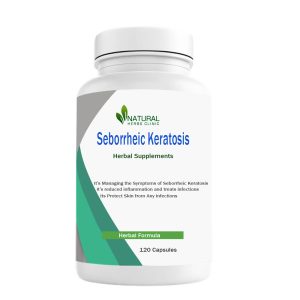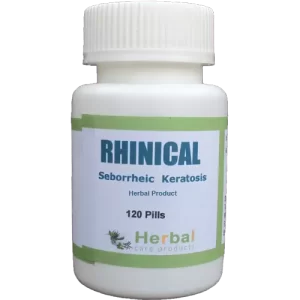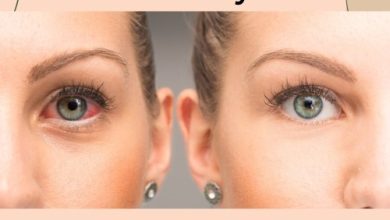How to Get Rid of Seborrheic Keratosis Fast – No Dermatologist Needed
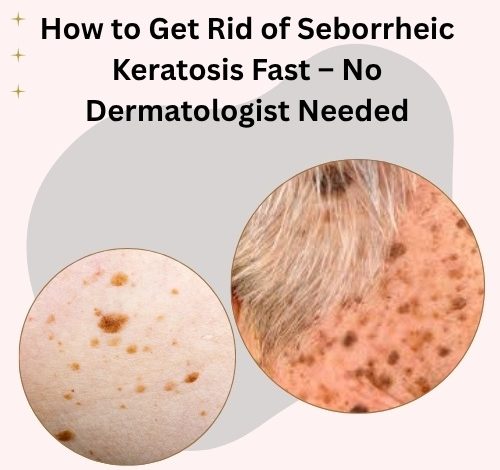
Seborrheic keratosis may sound intimidating, but it’s one of the most common, non-cancerous skin growths people develop with age. While these brown or black waxy spots are harmless, they can be unsightly, itchy, or irritating—especially if located in visible areas like the face, neck, or chest. Many people rush to the dermatologist for removal, but the truth is: you may not need medical intervention at all.
There are effective natural remedies for seborrheic keratosis that you can try at home to improve the appearance of these growths safely and naturally. The best natural treatment for seborrheic keratosis, how it works, what to avoid, and how to support your skin’s healing process. If you’re ready to tackle those stubborn skin spots naturally—keep reading.
What is Seborrheic Keratosis?
Seborrheic keratosis is one of the most common noncancerous skin growths seen in older adults. While its name may sound alarming, seborrheic keratosis is harmless and typically poses no health risks. It can, however, cause concern due to its appearance, especially if it mimics skin cancer or appears suddenly. Understanding what seborrheic keratosis is, what causes it, and how it can be treated helps put this benign condition into perspective.

Related Article: Seborrheic Keratosis Symptoms, Causes, Diagnosis and Treatment
Understanding Seborrheic Keratosis
Seborrheic keratosis (pronounced seb-o-REE-ik ker-uh-TOE-sis) is a type of benign skin lesion that develops on the outer layer of the skin, known as the epidermis. These growths often appear as waxy, wart-like, or scaly patches that seem to be “stuck on” the skin. They come in various colors—typically brown, black, or tan—and vary in size from a few millimeters to several centimeters.
Seborrheic keratoses can appear anywhere on the body, except the palms and soles. They are most commonly found on the chest, back, scalp, face, or neck. While they can appear singly, they often appear in clusters, particularly in older individuals.
What Causes Seborrheic Keratosis?
The exact cause of seborrheic keratosis remains unknown, but several factors are believed to contribute to its development:
- Aging: The most significant risk factor is age. Seborrheic keratoses typically begin to appear in middle age and become more common with advancing years.
- Genetics: A hereditary tendency is evident in many cases. If your parents had seborrheic keratoses, there’s a higher chance that you might develop them as well.
- Sun Exposure: Although not directly proven, long-term sun exposure may play a role, especially since many lesions occur on sun-exposed areas.
- Friction: Some studies suggest that areas subject to friction—like under the breasts or in skin folds—might be more prone to these growths.
Seborrheic keratoses are not contagious and do not result from a virus, bacteria, or other infectious agents. They are strictly a dermatological condition unrelated to personal hygiene or underlying infections.
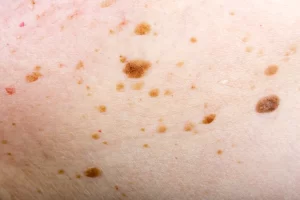
Related Article: Is Seborrheic Keratosis Bothering You? Here’s How Castor Oil Can Help
Symptoms and Appearance
Seborrheic keratosis can look quite different from person to person, but there are common features that make diagnosis easier:
- Texture: The surface may be wart-like, rough, waxy, or smooth. Some are flat, while others are raised.
- Color: Usually brown, but can range from light tan to black.
- Shape: Often oval or round, with well-defined borders.
- Size: Varies greatly; some are the size of a pinhead, while others can grow to several centimeters.
- Growth Pattern: Lesions usually start small and grow slowly over time.
Sometimes, a seborrheic keratosis may itch, especially if it’s irritated by clothing or scratching. Rarely, they can become inflamed or bleed, particularly if picked at or rubbed.
Why Choose Natural Remedies Over Medical Procedures?
Medical treatments like cryotherapy (freezing), electrosurgery (burning), or laser removal are effective, but they come with downsides:
- High costs
- Scarring or skin discoloration
- Risk of infection
- Not always covered by insurance
Natural remedies are gentler, cost-effective, and can often be done using ingredients already in your kitchen or medicine cabinet. While these remedies may take longer to show results, they avoid harsh chemicals and promote healing naturally.
Related Article: Reverse Seborrheic Keratosis Naturally: These Supplements May Be the Key
Top Natural Remedies for Seborrheic Keratosis
Let’s dive into the most effective natural remedies for seborrheic keratosis that people swear by.
1. Apple Cider Vinegar (ACV)
How it works: ACV contains acetic acid, which helps break down the keratin buildup in the seborrheic keratosis growth. It also has antibacterial and antifungal properties.
How to use:
- Soak a cotton ball in raw, unfiltered apple cider vinegar.
- Apply it directly to the affected area.
- Secure it with a bandage or medical tape.
- Leave it on for 2–3 hours daily or overnight.
- Repeat for several days or until the lesion darkens, crusts, and eventually falls off.
Caution: Avoid using ACV on broken skin or near the eyes.
2. Castor Oil and Baking Soda Paste
How it works: Castor oil has anti-inflammatory and moisturizing properties, while baking soda acts as a gentle exfoliant to remove dead skin.
How to use:
- Mix equal parts castor oil and baking soda into a thick paste.
- Apply the paste to the seborrheic keratosis.
- Cover with a bandage overnight.
- Wash off in the morning.
- Use daily for 2–3 weeks for best results.
This natural treatment for seborrheic keratosis is slow but often effective and skin-friendly.
3. Tea Tree Oil
How it works: Tea tree oil is antifungal, antibacterial, and antiviral. It may help dry out seborrheic keratosis over time, especially if the lesion is inflamed or irritated.
How to use:
- Mix a few drops of tea tree oil with a carrier oil (like coconut or olive oil).
- Dab the mixture onto the lesion using a clean cotton swab.
- Repeat twice daily.
Note: Always dilute tea tree oil to avoid irritation.
4. Aloe Vera Gel
How it works: Aloe vera is soothing, hydrating, and has wound-healing properties. It doesn’t remove SKs quickly, but it can help soften the lesion and reduce irritation.
How to use:
- Apply fresh aloe vera gel (from the plant or pure store-bought) directly to the growth.
- Leave it on overnight.
- Rinse in the morning.
Combine aloe vera with ACV or tea tree oil for enhanced results.
5. Hydrogen Peroxide (35% Food-Grade)
How it works: Hydrogen peroxide helps to oxidize and destroy abnormal skin cells. Many people have reported successful at-home removal using this remedy.
How to use:
- Use a cotton swab to apply a drop of 35% food-grade hydrogen peroxide directly on the lesion.
- Apply 1–2 times per day.
- The lesion may blister or crust before falling off.
Important: Use with extreme caution. 35% hydrogen peroxide is potent. Wear gloves and never apply on healthy skin.
6. Vitamin C (Ascorbic Acid)
How it works: Vitamin C promotes collagen production and skin regeneration. When applied topically, it may gradually break down the lesion.
How to use:
- Crush a vitamin C tablet and mix with a small amount of water to form a paste.
- Apply to the lesion and cover with a bandage.
- Leave on for several hours or overnight.
This natural remedy for seborrheic keratosis is best for sensitive skin types.
7. Banana Peel
How it works: Banana peel contains antioxidants and natural enzymes that may help in skin exfoliation and softening the growth.
How to use:
- Cut a piece of ripe banana peel.
- Place the inside of the peel on the seborrheic keratosis.
- Tape it in place and leave overnight.
This method may take a few weeks but is completely non-irritating.
Bonus: Internal Support for Skin Health
While topical treatments target the lesion directly, supporting your skin health from the inside out can accelerate healing and reduce future growths. Consider these dietary and supplemental strategies as part of your natural treatment for seborrheic keratosis:
1. Antioxidant-Rich Foods
Eat foods high in vitamins A, C, E, and selenium. These nutrients combat oxidative stress and support skin renewal.
Top choices: Berries, leafy greens, citrus fruits, carrots, sweet potatoes, and nuts.
2. Omega-3 Fatty Acids
These reduce inflammation and improve skin barrier function.
Sources: Fatty fish, flaxseed, chia seeds, walnuts.
3. Zinc Supplements
Zinc boosts skin healing and immune function. It may help reduce chronic skin conditions.
4. Probiotics
A healthy gut equals healthier skin. Probiotic-rich foods like yogurt, kefir, and fermented vegetables can aid overall skin balance.
What to Avoid During Natural Treatment
To prevent worsening the condition or causing skin damage, avoid the following:
- Picking or scratching the lesion – can lead to bleeding or infection.
- Using undiluted essential oils – always mix with a carrier oil.
- Excessive sun exposure – use natural sunscreen if needed.
- Harsh chemical peels – not recommended without supervision.
Always patch-test any remedy on a small area before applying it widely.
When to See a Dermatologist
While the focus of this article is how to get rid of seborrheic keratosis fast without a dermatologist, you should consult a medical professional if:
- The growth changes shape, color, or size rapidly
- It starts bleeding or oozing
- It becomes very painful or inflamed
- You’re unsure if it’s a seborrheic keratosis or a malignant growth
Early diagnosis is key if you suspect something abnormal. When in doubt—get it checked.
Frequently Asked Questions (FAQs)
Q1: Are natural remedies for seborrheic keratosis safe for sensitive skin?
Yes, remedies like aloe vera, diluted tea tree oil, and banana peel are generally safe. Always patch-test before use.
Q2: How long do natural treatments take to work?
It varies by individual and the size of the lesion, but visible results often take 1–4 weeks with consistent use.
Q3: Can seborrheic keratosis come back after removal?
Yes, while natural remedies may remove existing lesions, they don’t prevent new ones. Healthy lifestyle habits can help minimize recurrence.
Q4: Is seborrheic keratosis contagious?
No, seborrheic keratosis is not contagious and is not caused by viruses like warts.
Final Thoughts
Getting rid of seborrheic keratosis naturally is entirely possible with consistency and care. Whether you choose apple cider vinegar, castor oil and baking soda, or aloe vera and tea tree oil, these natural remedies for seborrheic keratosis can be incredibly effective over time.
Always remember that natural treatment for seborrheic keratosis requires patience. Results don’t happen overnight, but with regular application and internal skin support, you can significantly reduce or even eliminate these unwanted growths—no dermatologist necessary.

